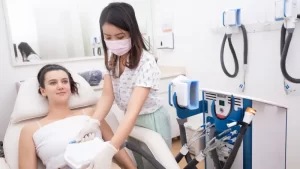Freeze Treatment: An Effective Solution for Skin Imperfections
Freeze treatment, often referred to as cryotherapy, is an innovative and increasingly popular solution for addressing various skin imperfections. This minimally invasive procedure uses extreme cold to target and treat skin concerns, offering quick and effective results. Here’s a closer look at why freeze treatment is becoming a go-to choice for dermatologists and patients alike.
How Freeze Treatment Works
Cryotherapy involves applying liquid nitrogen or another freezing agent directly to the affected area of the skin. The cold temperature destroys abnormal skin cells while promoting natural healing. The treatment is typically performed in a dermatologist’s office and requires minimal preparation.

What are the benefits of freeze treatment?
Freeze treatment is a versatile procedure that can be used to treat a variety of skin concerns, including:
- Skin lesions: It can be used to remove unwanted skin growths, such as moles, warts, skin tags, and other benign lesions.
- Skin rejuvenation: The procedure stimulates collagen production, which helps to reduce fine lines and wrinkles, improve skin texture, and promote a more youthful appearance.
- Acne: It can be used to reduce inflammation associated with acne, as well as reduce the appearance of acne scars.
- Dark spots and hyperpigmentation: The procedure can be used to remove dark spots and hyperpigmentation, resulting in a more even skin tone.
Common Skin Issues Treated with Freeze Therapy
- Warts: Cryotherapy is widely used to remove warts by freezing and destroying the tissue.
- Skin Tags: Freeze treatment can effectively and painlessly remove benign skin tags.
- Actinic Keratosis: Precancerous spots caused by sun exposure can be treated using cryotherapy to prevent further complications.
- Pigmentation Issues: Some forms of hyperpigmentation or age spots respond well to this treatment.
- Small Benign Tumors: Freeze therapy can also address certain non-cancerous growths.
Benefits of Freeze Treatment
- Quick Procedure: Sessions are typically brief, lasting only a few minutes.
- Minimal Downtime: Most patients resume daily activities immediately.
- Non-Surgical: The procedure avoids invasive techniques, reducing risks and scarring.
- Highly Effective: Cryotherapy often yields excellent results for minor skin imperfections.
What to Expect During and After the Procedure
During the procedure, patients may feel a brief stinging or burning sensation as the freezing agent is applied. After treatment, the skin may appear red or swollen for a short period, and in some cases, a blister may form. Healing typically occurs within one to two weeks, revealing smoother and healthier skin.
Safety Considerations
While generally safe, cryotherapy should be performed by a qualified professional to minimize risks such as scarring or over-treatment. People with certain skin conditions or sensitivities should consult their dermatologist to determine if freeze treatment is suitable for them.

How many sessions are required?
The number of freeze treatment sessions required depends on the individual’s skin concerns and the extent of the treatment area. Generally, a single session is sufficient for the removal of most skin lesions. However, for skin rejuvenation and other cosmetic concerns, multiple sessions may be required to achieve optimal results. Your healthcare provider can recommend a treatment plan that is tailored to your specific needs.
In conclusion, it is a safe and effective way to treat a variety of skin concerns. It is a non-invasive procedure that can be performed in a healthcare provider’s office, and requires no downtime.
